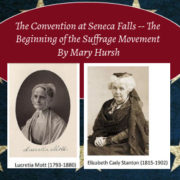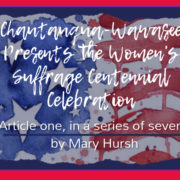A look at women’s suffrage in Indiana with Marsha Miller
By Mary Hursh
Over the past month, area residents have learned quite a bit about the woman’s suffrage movement which began in 1848 and culminated with the ratification of the 19th Amendment giving women the right to vote on August 26, 1920.
Speakers and events sponsored by Chautauqua-Wawasee and the Syracuse-Wawasee Historical Museum, Syracuse Public Library, Syracuse-Wawasee Chamber of Commerce and Indiana Humanities have introduced readers of the Mail Journal to many of the women involved in the fight for the vote. On September 5, Marsha Miller will present a program titled “From Amanda to Zerelda: Hoosier Suffragists Who Raised a Ruckus.”
Miller’s presentation to be held at the Syracuse Community Center on Saturday, September 5 from 2-3:30 p.m., will detail the “ruckus” caused by women involved in the suffrage movement. She describes it by saying “I have done a version of this program for several years. I will present a timeline which highlights the many ways women were stopped from speaking and expressing the need to have the vote. Nationally, women endured many hardships in the long struggle for the vote including forced feedings and standing as silent sentinels for hours on end trying to bring their cause to light.”
The “Amanda” in the title refers to Amanda Way (1828-1914), and the “Zerelda” in the title refers to Zerelda Gray Wallace (1817-1901). Way was deemed the mother of the women’s rights movement in Indiana and a founding member of the Indiana Woman’s Rights Association (1851). Wallace was the first lady of Indiana from 1837-1840. She formed the Equal Suffrage Society of Indianapolis and lobbied heavily to win the vote. She instigated several letter-writing campaigns, gathered petitions, and gave several speeches in support of suffrage, including in front of the U.S. Senate Committee (1870).
Miller’s presentation will feature historical costumes and suffragists songs. She says “People will not know the songs, but they will know the melodies. Suffragists created songs, poems, stories and plays. The lyrics to their songs were matched to tunes everyone would be familiar with, especially the “Battle Hymn of the Republic.” The songs helped to stir up positive and patriotic emotions which caused audiences to think favorably about women getting the vote.” Terre Haute personages Ida Husted Harper (1851-1931) and Eugene (1855-1926) and Kate Debs (1867-1936), will also be featured. Harper was the biographer of Susan B. Anthony and co-editor with her of the six-volume History of Woman Suffrage. Eugene and Kate Debs were supporters of full equal rights for women through their involvement with politics.
“I hope the audience on Saturday will take away some basic facts about suffrage as it was in Indiana. There is so much history hiding in local archives, on microfilm, in a historical society or a folder of clippings. I hope the people listening to my presentation will make it a point to look at primary sources in the library to learn about this state-wide movement,” said Miller.
(*** To view lecture on Saturday at 2pm eastern time via Zoom, please click here***)
Women in the suffrage movement used many techniques and strategies to present an organized front. “ When I visited the Sewall-Belmont House ( now the Belmont-Paul Women’s Equality National Monument) in Washington, DC., I learned that women kept cards of information on U.S. legislators, so in their lobbying efforts, they knew what legislators were for or against suffrage and if the legislator was a Republican or a Democrat.” Telegraphs, letters, and eventually phone calls were used as networking tools to get the word out to women. Their planning was unbelievable.”
Marsha Miller earned her bachelor of arts in history from Central Michigan University and her masters of library science from the University of Michigan. She was the periodicals reference librarian at Arkansas State University for five years and has been at Indiana State University since 1985 as a research and instructional librarian. There she is tied specifically to the College of Health and Human Services where she works with social work, physical education, occupational and physical therapy and sometimes nursing. “I also work with our School of Music which gives me the most personal joy, as I am a clarinetist, and with our Multidisciplinary Studies Department, which houses our Gender Studies program, part of the reason and inspiration for my development of this presentation.”
“There are so many interesting things to learn about suffrage. I now have a stack of books to read to learn what women did after they got the vote. I enjoy reading about Ida Husted Harper. I have been purposely collecting children’s books on women’s suffrage. One interesting book I read on the subject is The Hope Chest, by Karen Schwabach, written about the final weeks of suffrage ratification in Tennessee. Two little girls are the main characters. I have been collecting children’s books on women’s suffrage from the 80s and 90s.”
In keeping with her interest in suffrage, Miller contributes articles to the monthly publication called Terre Haute Living Magazine. “This year, I will have one article in that publication from August through November.”
Miller has spent a lengthy period of time at Indiana State University. “I feel that I can make a difference here at Indiana State University. In my main role, I have conducted more than 4,800 library/research instruction sessions. I have been able to serve on a number of campus committees. Currently I am working with our University College Council, which works with first-year students within our Foundational Studies program.
This article is the seventh in a series on the Women’s Suffrage Centennial sponsored by Chautauqua-Wawasee, Syracuse-Wawasee Historical Museum, Syracuse Public Library, Syracuse-Wawasee Chamber and Indiana Humanities. All events are free and open to the public.
Chautauqua-Wawasee is a non-profit organization which provides life enriching programs for the northern Indiana region.
Mary Hursh is a freelance writer who lives on Syracuse Lake with her husband Stanley.




